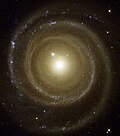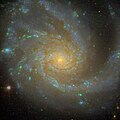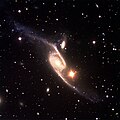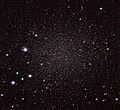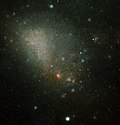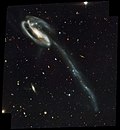Top Qs
Timeline
Chat
Perspective
List of galaxies
List of some galaxies From Wikipedia, the free encyclopedia
Remove ads
There are an estimated 100 billion galaxies in all of the observable universe.[1] On the order of 100,000 galaxies make up the Local Supercluster, and about 51 galaxies are in the Local Group (see list of nearest galaxies for a complete list).

The first attempts at systematic catalogues of galaxies were made in the 1960s, with the Catalogue of Galaxies and Clusters of Galaxies listing 29,418 galaxies and galaxy clusters, and with the Morphological Catalogue of Galaxies, a putatively complete list of galaxies with photographic magnitude above 15, listing 30,642. In the 1980s, the Lyons Groups of Galaxies listed 485 galaxy groups with 3,933 member galaxies. Galaxy Zoo is a project aiming at a more comprehensive list: launched in July 2007, it has classified over one million galaxy images from The Sloan Digital Sky Survey, The Hubble Space Telescope and the Cosmic Assembly Near-Infrared Deep Extragalactic Legacy Survey.[2]
Remove ads
Named galaxies
Summarize
Perspective
This section needs additional citations for verification. (January 2025) |
This is a list of galaxies that are well known by something other than an entry in a catalog or list, or a set of coordinates, or a systematic designation.
Remove ads
Naked-eye galaxies
Summarize
Perspective
This is a list of galaxies that are visible to the naked eye, for at the very least, keen-eyed observers in a very dark-sky environment that is high in altitude, during clear and stable weather.
- Sagittarius Dwarf Spheroidal Galaxy is not listed, because it is not discernible as being a separate galaxy in the sky.
Remove ads
Observational firsts
Prototypes
This is a list of galaxies that became prototypes for a class of galaxies.
Remove ads
Closest and most distant-known galaxies by type
Summarize
Perspective
Closest galaxies
This section needs additional citations for verification. (January 2025) |
Most distant galaxies
Timeline notes
- MACS0647-JD, discovered in 2012, with z=10.7, does not appear on this list because it has not been confirmed with a spectroscopic redshift.[143]
- UDFy-38135539, discovered in 2009, with z=8.6, does not appear on this list because its claimed redshift is disputed.[144] Follow-up observations have failed to replicate the cited redshift measurement.[citation needed]
- A1689-zD1, discovered in 2008, with z=7.6, does not appear on this list because it has not been confirmed with a spectroscopic redshift.
- Abell 68 c1 and Abell 2219 c1, discovered in 2007, with z=9, do not appear on this list because they have not been confirmed.[145]
- IOK4 and IOK5, discovered in 2007, with z=7, do not appear on this list because they have not been confirmed with a spectroscopic redshift.
- Abell 1835 IR1916, discovered in 2004, with z=10.0, does not appear on this list because its claimed redshift is disputed. Some follow-up observations have failed to find the object at all.[citation needed]
- STIS 123627+621755, discovered in 1999, with z=6.68, does not appear on this list because its redshift was based on an erroneous interpretation of an oxygen emission line as a hydrogen emission line.[146][147][148]
- BR1202-0725 LAE, discovered in 1998 at z=5.64 does not appear on the list because it was not definitively pinned. BR1202-0725 (QSO 1202-07) refers to a quasar that the Lyman alpha emitting galaxy is near. The quasar itself lies at z=4.6947[99][102]
- BR2237-0607 LA1 and BR2237-0607 LA2 were found at z=4.55 while investigating around the quasar BR2237-0607 in 1996. Neither of these appear on the list because they were not definitively pinned down at the time. The quasar itself lies at z=4.558[149][150]
- Two absorption dropouts in the spectrum of quasar BR 1202-07 (QSO 1202-0725, BRI 1202-0725, BRI1202-07) were found, one in early 1996, another later in 1996. Neither of these appear on the list because they were not definitively pinned down at the time. The early one was at z=4.38, the later one at z=4.687, the quasar itself lies at z=4.695[98][151][152][153][154]
- In 1986, a gravitationally lensed galaxy forming a blue arc was found lensed by galaxy cluster CL 2224-02 (C12224 in some references). However, its redshift was only determined in 1991, at z=2.237, by which time, it would no longer be the most distant galaxy known.[155][156]
- An absorption drop was discovered in 1985 in the light spectrum of quasar PKS 1614+051 at z=3.21 This does not appear on the list because it was not definitively fixed down. At the time, it was claimed to be the first non-QSO galaxy found beyond redshift 3. The quasar itself is at z=3.197[98][157]
- From 1964 to 1997, the title of most distant object in the universe was held by a succession of quasars.[105] That list is available at list of quasars.
- In 1958, clusters Cl 0024+1654 and Cl 1447+2619 were estimated to have redshifts of z=0.29 and z=0.35, respectively. However, no galaxy was spectroscopically determined.[121]
Remove ads
Galaxies by brightness and power
Remove ads
Galaxies by mass and density
Remove ads
Galaxies by size
Remove ads
Interacting galaxies
Galaxy mergers
Remove ads
Galaxies with some other notable feature

Remove ads
See also
- Infinity galaxy - First galaxy to show evidence of formation of supermassive black holes, through the direct collapse mechanism.
- Blueberry galaxy - Small and very active galaxies.
- Galaxy
- Galaxy groups and clusters
- Illustris project
- List of galaxy groups and clusters
- List of galaxy superclusters
- Lists of astronomical objects
- Local Group
- Milky Way Galaxy
- Supercluster
- Virgo Supercluster
Lists of galaxies
Remove ads
Notes
- Excluding the Sun. Using the formula for addition of apparent magnitudes, the added magnitudes of all stars in the Milky Way but the Sun (−6.50) and the Sun (−26.74) differs from the apparent magnitude of just the sun by less than 10^-8.[186]
- z represents redshift, a measure of recessional velocity and inferred distance due to cosmological expansion.
References
External links
Wikiwand - on
Seamless Wikipedia browsing. On steroids.
Remove ads





